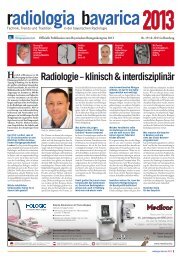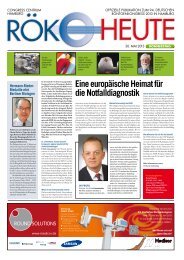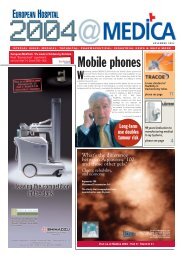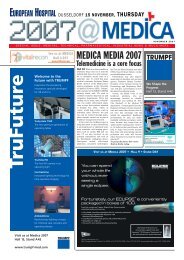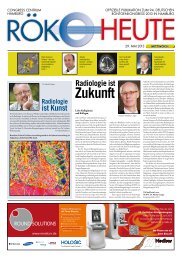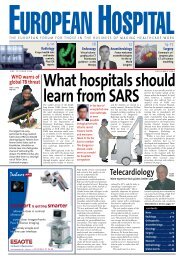PET scanning the heart cuts costs - European-Hospital
PET scanning the heart cuts costs - European-Hospital
PET scanning the heart cuts costs - European-Hospital
You also want an ePaper? Increase the reach of your titles
YUMPU automatically turns print PDFs into web optimized ePapers that Google loves.
RADIOLOGY - MOLECULAR IMAGING<br />
THE COMING ERA OF GENETIC MEDICINE<br />
By Stefan G Ruehm MD PhD,<br />
Associate Professor of<br />
Radiology, at <strong>the</strong> David<br />
Geffen School of Medicine,<br />
UCLA,California<br />
With advances in radiology<br />
over recent years<br />
medical imaging has<br />
become more precise,<br />
meanwhile even allowing for<br />
functional and metabolic analysis.<br />
It can be expected that imaging<br />
with genetic and molecular markers<br />
will play an important role in<br />
<strong>the</strong> foreseeable future. New developments<br />
in contrast media<br />
research, with <strong>the</strong> design of biologically<br />
specific contrast agents<br />
for a variety of imaging techniques,<br />
and for magnetic resonance<br />
imaging in particular, are<br />
expected to fur<strong>the</strong>r contribute to<br />
<strong>the</strong> accuracy of medical imaging.<br />
Molecular imaging may be<br />
characterised as <strong>the</strong> in vivo visualisation<br />
of specific biological<br />
processes at <strong>the</strong> cellular or even<br />
molecular level. It aims at <strong>the</strong><br />
detection of early underlying biochemical<br />
and genetic alterations<br />
responsible for various disease<br />
entities ra<strong>the</strong>r than late changes as<br />
demonstrated by most current<br />
diagnostic imaging tools.<br />
Excellent soft tissue contrast,<br />
high anatomical resolution and<br />
multiplanar imaging capabilities<br />
qualify MRI for molecular imaging.<br />
Compared with positron<br />
emission tomography (<strong>PET</strong>), with<br />
or without computed tomographic<br />
imaging (<strong>PET</strong>/CT), MRI does<br />
not require coregistration of molecular<br />
activity with anatomical<br />
structures. In addition, <strong>the</strong> lack of<br />
radiation exposure fur<strong>the</strong>r favours<br />
<strong>the</strong> use of MRI. However, relatively<br />
large and potentially toxic<br />
concentrations of imaging markers<br />
are commonly necessary to<br />
visualise molecular events, representing<br />
some of <strong>the</strong> challenges<br />
faced by molecular MRI.<br />
For a successful implementation<br />
of molecular MRI <strong>the</strong> following<br />
criteria should be fulfilled:<br />
● sufficient MR contrast to depict<br />
changes on a cellular or molecular<br />
level<br />
● favourable safety features of <strong>the</strong><br />
contrast agent / molecular<br />
probe; and<br />
● usefulness of <strong>the</strong> probe with<br />
proven validation for basic science<br />
or clinical application.<br />
The current probes for molecular<br />
MRI combine ei<strong>the</strong>r a paramagnetic<br />
or superparamagnetic<br />
contrast compound with a ligand.<br />
The ligand binds with high affinity<br />
to a molecular target or receptor,<br />
which usually serves as an<br />
imaging biomarker, allowing<br />
assessing <strong>the</strong> presence or severity<br />
of disease. Targets may range<br />
from copies of DNA to multiple<br />
intra- or extracellular proteins or<br />
metabolites. The capacity of a<br />
probe to detect <strong>the</strong> target molecule<br />
follows <strong>the</strong> rules of classic<br />
pharmacology. Therefore, <strong>the</strong><br />
route of administration, distribution<br />
and delivery to <strong>the</strong> target,<br />
followed by elimination through<br />
metabolism or excretion, need to<br />
be considered. As <strong>the</strong> ligandreceptor<br />
interaction is dynamic in<br />
nature, <strong>the</strong> correct timing of <strong>the</strong><br />
imaging data acquisition is crucial.<br />
Usually molecular contrast agents<br />
require a 24-hour period after<br />
administration until a significant<br />
amount of <strong>the</strong> probe has accumulated<br />
at <strong>the</strong> target to provide sufficient<br />
signal for MR imaging.<br />
Therefore, registration of pre- and<br />
postcontrast data sets is usually<br />
required. Image resolution and<br />
speed of data acquisition are fur<strong>the</strong>r<br />
important determinants for<br />
<strong>the</strong> depiction of signal changes.<br />
A substantially different means<br />
of imaging molecular events is MR<br />
spectroscopy. This relies on <strong>the</strong><br />
detection of a spectroscopic peak<br />
at a certain location, generated by<br />
a metabolite that is produced by,<br />
or heralds, alterations on a molecular<br />
level.<br />
Clinical Applications of molecular<br />
MRI include oncologic imaging,<br />
detection of thrombosis as<br />
well as imaging of inflammatory<br />
and/or rheumatoid disease. In<br />
addition, genetic and cell-based<br />
<strong>the</strong>rapies are likely to benefit from<br />
Impact<br />
your entire care process<br />
molecular imaging.<br />
Molecular MRI holds promise<br />
to enhance tumor detection, to<br />
provide accurate staging, to monitor<br />
<strong>the</strong>rapeutic response and to<br />
survey for recurrent disease. The<br />
primary goal in oncologic imaging<br />
is to improve <strong>the</strong> detection of<br />
malignant cells, both at <strong>the</strong> primary<br />
site of origin and at locations of<br />
metastasis. As a common characteristic<br />
tumor growth is paralleled<br />
by <strong>the</strong> de novo formation of blood<br />
continued on page 16<br />
Fig 1a) Fig 1b)<br />
3D data set of neck vessels in rabbit (Fig. 1a) prior to<br />
and (Fig. 1b) post administration of contrast agent<br />
targeted to bind to fibrin identifies clots with high<br />
signal intensity in jugular vein (arrow) and carotid<br />
artery (arrowhead). Courtesy of Epix Pharmaceuticals,<br />
Cambridge, MA, USA<br />
Dräger Medical’s CareArea Solutions deliver integrated medical<br />
systems and services that are evolutionizing <strong>the</strong> acute point of care.<br />
Leading-edge solutions for information management, patient monitoring,<br />
<strong>the</strong>rapy and architectural systems help you redefine process efficiency…<br />
from <strong>the</strong> ground up and <strong>the</strong> patient out. Innovative Education & Training<br />
tools, trusted DrägerService ® and smart accessories help you constantly<br />
optimize care processes over time. Plus, cross area benefits that span<br />
Emergency Care, Perioperative Care, Critical Care, Perinatal Care and<br />
Home Care offer synergies that amplify <strong>the</strong> impact of our CareArea<br />
Solutions throughout <strong>the</strong> patient care process.<br />
To see how dramatically <strong>the</strong>y can impact your business of care visit us in<br />
<strong>the</strong> internet at www.draeger-medical.com<br />
Emergency Care·Perioperative Care·Critical Care·Perinatal Care·Home Care Because you care<br />
EUROPEAN HOSPITAL Vol 14 Issue 2/05 15<br />
Stefan G<br />
Ruehm, MD



